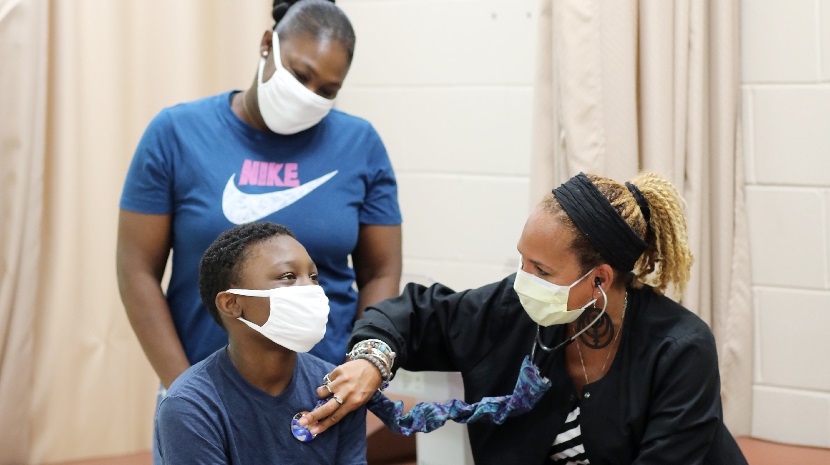Systemic Racism Explains Most Differences in Asthma Re-Admission Rates
Research By: Tesfaye Mersha, PhD | Robert Kahn, MD, MPH
Post Date: September 28, 2021 | Publish Date: July 1, 2021

Studies have shown for many years that Black children with asthma are re-admitted to hospitals more often than White children with asthma. Now, a deeper analysis led by experts at Cincinnati Children’s reports that the difference is more about structural racism built into the health system than it is about genetic differences.
Findings were published online July 1, 2021, in the Journal of Allergy and Clinical Immunology.
This study involved 695 children with asthma, aged 1-16 years. The researchers tracked how many of those children were re-admitted to a hospital within one year of a prior hospital admission.
The study reports that 134 children were re-admitted within a year. Of those, 126 self-identified as Black vs. 28 self-identifying as white.
The researchers went beyond self-identification to determine whether the children actually carried one or more of several single nucleotide polymorphisms (SNPs) known to reflect African genetic heritage.
That analysis did show that patients with higher African ancestry had a higher readmission rate than those with fewer African ancestry SNPs. However, the genetic difference vanished into statistical insignificance once several measures of hardship, heavily linked to structural racism, were factored in.
“Our mediation analysis showed that the relationship between genetic ancestry and pediatric asthma readmission is quite complex and largely mediated by social and environmental factors,” says the study’s lead author Tesfaye Mersha, PhD. “If inequities caused by social and environmental differences as a result of historical structural racism were to be corrected, the wide gap in hospital readmissions between black and white children with asthma would be much less.”
Co-authors included Ke Qin, PhD, Andrew Beck, MD, MPH, Lili Ding, PhD, Bin Huang, PhD, and senior author Robert Kahn, MD, MPH.
Several factors stacked against Black children with asthma
In previous research, experts at Cincinnati Children’s found that half of the Black-White difference in hospital re-admissions could be explained by financial and social hardships, such as low-income and disrupted family life.
In this paper, the team found that environmental, disease management, and access-to-care factors explain another 30 percent of the variation between the two groups.
Disease management gaps emerged as the highest direct trigger for hospital re-admission. The team assessed factors such as how many nights per week the patients slept away from home, whether the patients missed medicine doses, and whether the family ran out of medicines. They found that sleeping away from home contributed strongly to Black children missing their asthma medications.
Access to care difficulties included low income, lack of access to a car, and type of insurance. The strongest indicator: children covered by Medicaid were more likely to seek hospital care than those with private coverage.
The study also reported that Black children were more likely to be exposed to outdoor environmental factors that trigger asthma complications. The biggest factor: the distance from their homes to a highway. Living closer to highways exposes people to higher levels of particulate pollution–primarily from diesel truck exhaust.
Meanwhile indoors, lower-quality housing occupied by lower-income Black families can expose children with asthma to triggers including mold, lingering tobacco smoke, and dander from cockroaches and rats.
Implications for “race” as a health risk factor
This study further supports the acknowledgement among social scientists that race is a social construct. While ancestry can be shown as a genetic construct, the data here shows that genetic variations played far less of a role in explaining asthma re-admission rates than the constellation of factors linked to systemic racism.
“Importantly, the absence of a direct ancestry effect on readmission after accounting for these mediating pathways is consistent with the notion that asthma-related racial disparities are likely driven by factors linked to structural racism and social adversities,” the co-authors wrote. “These results suggest future studies of reported race, genetic ancestry, and health outcomes should include measurement of relevant social and environmental variables.”
Read more about a related finding:
Neighborhood Poverty, Public Insurance Status Outweigh Race for Risk of Diabetes-Related Hospitalization
View coverage:
| Original title: | Genetic ancestry differences in pediatric asthma readmission are mediated by socioenvironmental factors |
| Published in: | Journal of Allergy and Clinical Immunology |
| Publish date: | July 1, 2021 |
Research By








